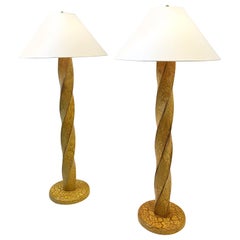Dana Creath
Recent Sales
Vintage 1980s American Modern Floor Lamps
Wood
Steve Chase for sale on 1stDibs
Steve Chase lived in and worked out of Palm Springs, California, but he created luxury spaces and furniture for projects that took shape all over the world. A consummate art collector and brilliant interior designer, Chase was involved in every aspect of the rooms he designed and attracted many high-profile clients, including Gerald and Betty Ford, Farrah Fawcett and Gene Hackman.
Chase was born in New Hampshire and attended the Rhode Island School of Design as well as the ArtCenter in Los Angeles. After completing his studies, he joined Arthur Elrod and Associates — a celebrated Palm Springs-based firm that created colorful interiors and furniture for a range of Hollywood stars and more during the height of the mid-century modern era. Chase worked with Elrod for more than a decade before establishing his own business in 1980.
Chase designed his furniture to meet the sensibilities and personalities of his clients, and his work ranged from the traditional to the tastefully unconventional. While he created sculptural brass side tables that boast striking brutalist forms, there were also understated chrome-framed coffee tables with fossil shell tops. For his seating, Chase’s palette ranged from bright pastels to modest earth tones, and his vintage sofas are known for their signature tufted-channel backrests and seats. The plush cushioning was most prevalent in his Monterey seating collection of chairs, sectionals and sofas manufactured by the firm Martin Brattrud Inc., which produced most of Chase's designs during the 1970s and '80s.
Chase supported a number of charitable organizations and strongly advocated for the Desert AIDS Project (DAP), a volunteer-led initiative to combat the HIV epidemic in Coachella Valley. He lent his design talents to improve their office space, and used his influence with celebrities to enlist their help on the project. Chase also joined the Contemporary Art Council Acquisitions Committee at the Palm Springs Art Museum and eventually bequeathed more than 130 works to the institution when he passed away in 1994.
In 1996, the DAP created the annual Steve Chase Humanitarian Awards to honor him. Today he is remembered for his humanitarian giving as often he is for his furniture designs and lively interiors.
On 1stDibs, explore an array of vintage Steve Chase chairs, tables and lighting.
A Close Look at modern Furniture
The late 19th and early 20th centuries saw sweeping social change and major scientific advances — both of which contributed to a new aesthetic: modernism. Rejecting the rigidity of Victorian artistic conventions, modernists sought a new means of expression. References to the natural world and ornate classical embellishments gave way to the sleek simplicity of the Machine Age. Architect Philip Johnson characterized the hallmarks of modernism as “machine-like simplicity, smoothness or surface [and] avoidance of ornament.”
Early practitioners of modernist design include the De Stijl (“The Style”) group, founded in the Netherlands in 1917, and the Bauhaus School, founded two years later in Germany.
Followers of both groups produced sleek, spare designs — many of which became icons of daily life in the 20th century. The modernists rejected both natural and historical references and relied primarily on industrial materials such as metal, glass, plywood, and, later, plastics. While Bauhaus principals Marcel Breuer and Ludwig Mies van der Rohe created furniture from mass-produced, chrome-plated steel, American visionaries like Charles and Ray Eames worked in materials as novel as molded plywood and fiberglass. Today, Breuer’s Wassily chair, Mies van der Rohe’s Barcelona chair — crafted with his romantic partner, designer Lilly Reich — and the Eames lounge chair are emblems of progressive design and vintage originals are prized cornerstones of collections.
It’s difficult to overstate the influence that modernism continues to wield over designers and architects — and equally difficult to overstate how revolutionary it was when it first appeared a century ago. But because modernist furniture designs are so simple, they can blend in seamlessly with just about any type of décor. Don’t overlook them.
Finding the Right floor-lamps for You
The modern floor lamp is an evolution of torchères — tall floor candelabras that originated in France as a revolutionary development in lighting homes toward the end of the 17th century. Owing to the advent of electricity and the introduction of new materials as a part of lighting design, floor lamps have taken on new forms and configurations over the years.
In the early 1920s, Art Deco lighting artisans worked with dark woods and modern metals, introducing unique designs that still inspire the look of modern floor lamps developed by contemporary firms such as Luxxu.
Popular mid-century floor lamps include everything from the enchanting fixtures by the Italian lighting artisans at Stilnovo to the distinctly functional Grasshopper floor lamp created by Scandinavian design pioneer Greta Magnusson-Grossman to the Paracarro floor lamp by the Venetian master glass workers at Mazzega. Among the more celebrated names in mid-century lighting design are Milanese innovators Achille and Pier Giacomo Castiglioni, who, along with their eldest brother, Livio, worked for their own firm as architects and designers. While Livio departed the practice in 1952, Achille and Pier Giacomo would go on to design the Arco floor lamp, the Toio floor lamp and more for legendary lighting brands such as FLOS.
Today’s upscale interiors frequently integrate the otherworldly custom lighting solutions created by a wealth of contemporary firms and designers such as Spain’s Masquespacio, whose Wink floor lamps integrate gold as well as fabric fringes.
Visual artists and industrial designers have a penchant for floor lamps, possibly because they’re so often a clever marriage of design and the functions of lighting. A good floor lamp can change the mood of any room while adding a touch of elegance to your entire space. Find yours now on 1stDibs.
